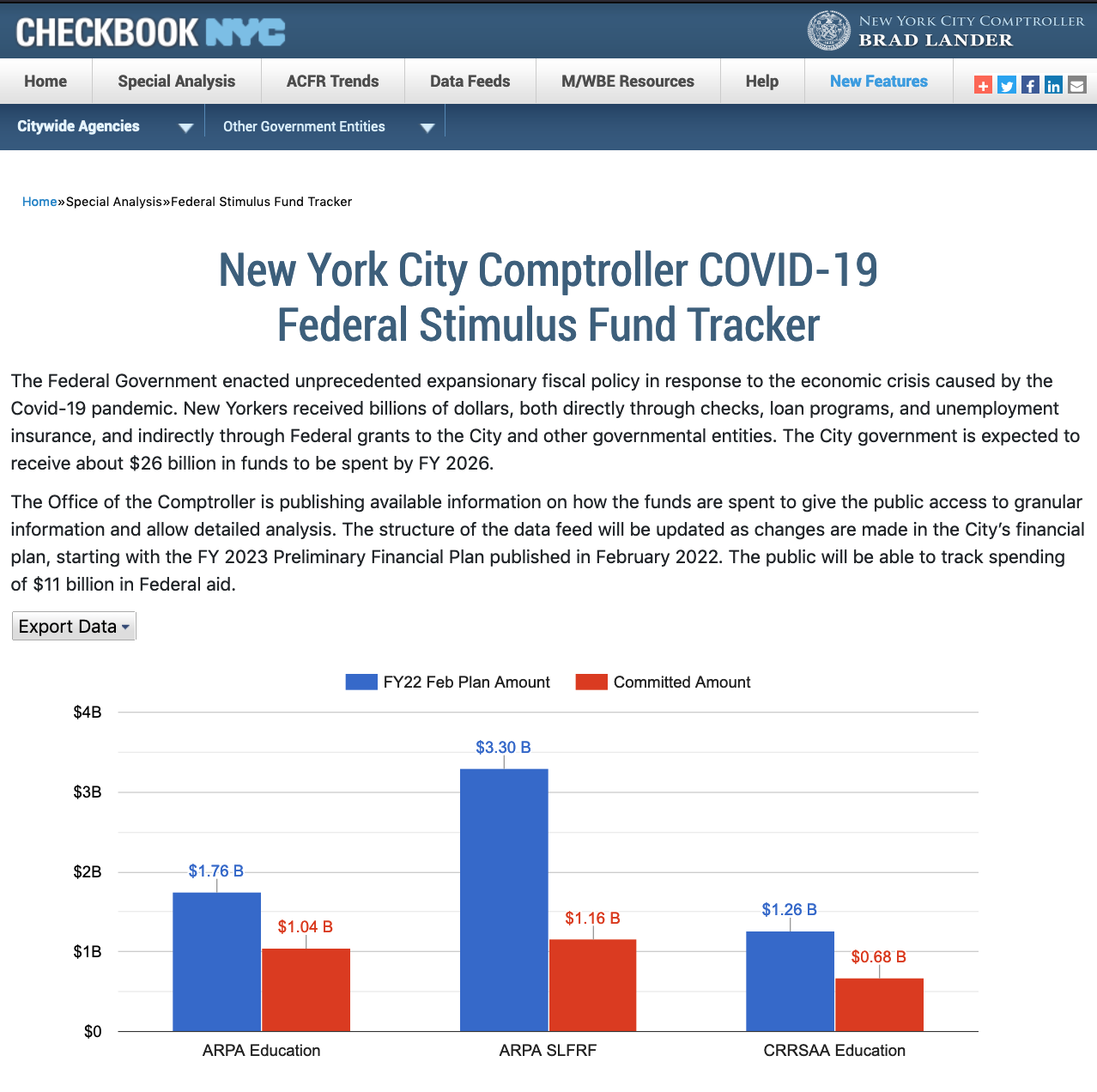
Data portal provides previously unpublished detail on the spending to date. Lander calls for additional transparency and tracking of outcomes to better assess the impacts of relief aid.
City Comptroller Brad Lander unveiled an interactive public dashboard tracking the spending from FY 2022 onward of nearly $11 billion in Federal pandemic relief funding for New York City. Through FY 2026, Federal pandemic aid is expected to total $26 billion. The tracker shows that through mid-February the City has spent $1.16 billion of $3.30 billion in planned State and Local Fiscal Recovery Fund (SLFRF) spending for FY 2022, and $1.7 billion of $3.0 billion in FY 2022 funds specifically awarded for education.
View the Federal Stimulus Fund Tracker here.
“This time-limited funding is a lifeline for New York City as we work to recover from a public health and economic crisis that has left too many of our neighbors struggling,” said Comptroller Brad Lander. “Spending this funding wisely is critical to securing a recovery that brings our city back to life, confronts the inequities that predated the pandemic, and prepares us better for future crises. Without clear goals, transparency and accountability, we run the risk of squandering this opportunity, getting too little for what we spend, and leaving our city with long-term spending obligations we can’t meet.”
Comptroller Lander has repeatedly called for clear goal-setting and tracking of Federal stimulus funding. The stimulus tracker released today is a big stride towards transparency regarding the amount and categories of spending, enabling the public to download planned and actual spending by agency, unit of appropriation, budget code and object code.
In setting up the tracker, the Comptroller’s Office identified significant limitations in the City’s ability to account for both the dollars spent and the outcomes achieved.
A complete and independent accounting of FY 2021 spending was hampered by budget codes that commingled funding sources, spending reallocations, and the addition of new budget codes. The NYC Office of Management and Budget reported $1.26 billion of SLFRF spending in FY 2021, but only $520 million could be independently identified in the City’s Financial Management System (FMS). Another $318 million is unaccounted for and is expected to be reallocated in future fiscal years. Due to the City’s inability to uniformly link grant funding sources to expenditures, there is no clear mechanism to monitor and control spending against grants by which the City can provide more accurate budget projections. The City’s Office of Management and Budget is well aware of these issues and the Comptroller’s office is committed to working with OMB to initiate a cost accounting feature in FMS, which is long overdue.
Lander also highlighted the lack of meaningful reporting on outcomes. Roughly half the total amount of Federal aid has been spent, yet few metrics are available to assess what New Yorkers are getting from this spending. The City released planned performance metrics for SLFRF funding in August, but has not published interim measures.
For school spending, the largest category of Federal funds, the City has not been clear about how it will track the impact of programs on students’ health and academic, social, and emotional recovery. The Department of Education (DOE) will receive a total of $7.7 billion in federal aid to be spent through FY 2025. Data available on the tracker show that the DOE has spent $725 million on maintaining safe and clean classrooms in the current school year, but has not provided data on the distribution of ventilation or measures of indoor air quality. More than $260 million has been spent on addressing “learning loss,” but no data is available to provide detail on what these funds bought or how the dollars have met the needs of students who have faced two traumatic years of pandemic loss and disruption in their personal and academic lives.
Lander continued, “The City has committed $121 million for rental assistance in FY 2022, how many households have received a voucher? $725 million was committed for school facilities, how much was spent on ventilation? The City set aside $261 million for ‘learning loss,’ how many reading coaches were hired? How many devices distributed? How many students with IEPs enrolled in after-school or Saturday classes?
“I urge the Administration to provide more detailed interim information on the outcomes of this spending so that we can ensure we’re getting the most out of every dollar to help our students, small businesses, and neighborhoods recover.”
In addition, the City is using time-limited Federal funds to pay for ongoing core instructional and support initiatives, and therefore may face risks continuing to fund these programs when stimulus funds expire. Chief among these is 3K expansion, which faces a risk of $376 million in FY 2026. The City would also need to provide additional funding of $111 million in FY 2025 and $235 million in FY 2026 as ongoing support of special education pre-kindergarten expansion, mental health services and community schools programs.
The COVID-19 Federal Stimulus Tracker, published on the Comptroller’s Checkbook NYC website, will allow detailed analysis of funds committed and spent to date. Spending data currently reflects spending plans as of the FY 2023 Preliminary Financial Plan released this February and will be regularly updated to mirror data recorded in the City’s Financial Management System (FMS).
Explore the Comptroller’s Federal Stimulus Tracker here: www.checkbooknyc.com/stimulus
No comments:
Post a Comment